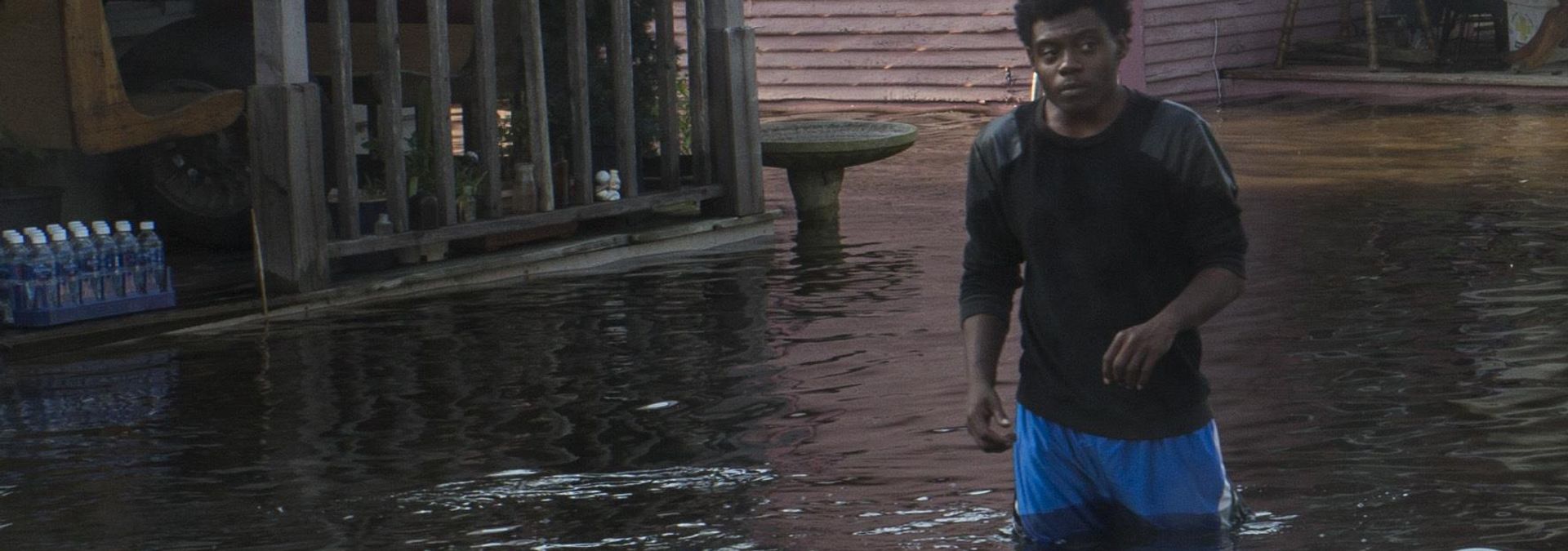
Where's the equity in Houston's climate action plan?
Without considering equity, Iris Gonzalez says, Houston will "continue falling into the patterns that leave some communities behind." Photo: Lance Cpl. Niles Lee.
As a lifelong resident of the Denver Harbor neighborhood in east Houston, Rita Robles routinely experiences the damaging effects of industrial pollution and environmental injustice.
The mother and grandmother says fumes from the nearby Clorox factory trigger her asthma on sunny days, as the putrid odor of sewage wafts from a water treatment plant. On rainy days, she sees narrow streets and alleys quickly flood.
Meanwhile, horns blare incessantly from the Union Pacific railyard a few blocks away, the source of creosote contamination that is the likely cause of a cancer cluster confirmed by state health officials late last year.
“It’s a combination of deterioration and neglect,” Robles explains, describing the longstanding problems that make living in environmental justice communities like Denver Harbor hazardous to health.
A year or so ago, when Robles learned that Houston was working on a climate plan to help make neighborhoods like hers safer and more resilient, she got excited — and involved. But as she followed the plan, which city council approved on Earth Day in April 2020, she became disillusioned. “It looks good on paper, but there isn’t anything in there that is going to help people in their current situation,” she says. “We haven’t seen anything substantive, and there is so much that needs to be done.”
So, what’s the plan?
Passage of Houston's Climate Action Plan on April 22 — the 50th anniversary of Earth Day — failed to command wide attention, as the city was reeling from the impacts of the coronavirus pandemic. Even the optimism of local environmental leaders was restrained. Many described it as a “first step.”
Houston, with its congested freeways and persistent industrial pollution, is one of the worst contributors in the U.S. of the emissions that are warming the atmosphere and changing the climate. And Texas spews more pollution from fossil fuels than any other state in the nation, according to the U.S. Energy Department.
As wind patterns are disturbed and oceans warm, the Houston region has been battered by increasingly ferocious hurricane seasons. In 2017, Hurricane Harvey devastated Houston, flooding more than 120,000 structures in Harris County alone and causing $125 billion in damage up and down the Texas coast.
The 100-page plan targets four primary areas to fight this: transportation, energy sources, buildings and waste management and disposal. It calls for shifting regional municipal fleets to low-emission and electric vehicles, investing in clean energy, slashing the amount of energy required to power buildings and reducing waste. The climate document also aims to make heavily industrial Houston a leader in carbon capture technology, while encouraging more transit, biking and walking.
Central to the blueprint is Mayor Sylvester Turner’s commitment to the 2017 Paris Agreement and its goal of carbon neutrality by 2050.
Where’s the equity?
Environmental experts praised the plan, but they were quick to note that it barely mentions “equity,” or a path to reducing environmental injustice in neighborhoods like Denver Harbor, where Robles lives.
“Equity ensures that communities that have been traditionally disinvested in, redlined and marginalized benefit — and potentially benefit more — than other communities,” said Stephanie Thomas, a researcher and community organizer with Public Citizen in Houston. “Equity is about recognizing the unequal impacts of pollution and climate disasters on some communities.”
But equity seems little more than a “talking point” in the plan to Iris Gonzalez, director of Houston’s Coalition for the Environment, Equity and Resilience, or CEER. The organization was formed after Harvey to address the disparities that disasters exacerbate. “The plan needs an innovative, creative way to engage and include the voices of impacted community members and people who are on the frontlines of the climate crisis,” she says. “It's already at their doorsteps, and it's only going to get worse.”
“When we're talking about equity, we're talking about institutional racism, and that is difficult for Americans to grapple with," Gonzalez said.
For now, Thomas urged Mayor Turner to create a task force to oversee the implementation of the plan with a focus on equity. Other cities — San Diego the most noteworthy — have developed equity scorecards to evaluate their plans’ effects on the communities impacted by environmental injustice, she said.
Darryl Alexander moved to Montrose in central Houston 18 months ago and immediately began tracking the city’s climate plan progress. At first, he liked what he heard. “It gave us a license to talk about climate change in Houston, and I don’t think that had happened much in the past,” he said.
Like Robles, though, his initial enthusiasm faded as he saw the plan enter its final stage. “It doesn’t mention the petrochemical industry at all, and there aren’t strong policy prescriptions in it. I don’t think it addresses inequities.”
No, the plan isn’t perfect — not by a long shot — but there is hope. Other major cities in Texas have adopted climate plans, with San Antonio last year and Dallas this May. After announcing Houston’s, Mayor Turner took the extra step of committing to using 100 percent renewable energy for city operations as soon as July.
But meeting the plan’s goals will require ambitious action. A plastics industry that relies on the region’s petrochemical facilities and shipping companies is growing rapidly, even increasing production during the coronavirus pandemic.
At the same time, state leadership in Texas has demonstrated little interest in addressing climate change; Gov. Abbott failed to respond to a group of Texas scientists who offered to help him understand the risks.
Meanwhile, his appointments to the Texas Commission on Environmental Quality, or TCEQ, have a history of slapping wrists and failing to enforce the environmental regulations the state has on the books. Since 2011, TCEQ has penalized companies for fewer than 3 percent of illegal releases of air pollutants. And when TCEQ does penalize these releases, it comes out to pennies per pound of pollution — only about $0.02 in 2017 — leaving billions of dollars in fines on the table.
“Houston,” Thomas said, “can’t do it alone.”
Still, Houston residents and advocates like Robles and Gonzalez who lived through the devastating impacts of climate change with Hurricane Harvey — and even Tropical Storm Imelda less than a year ago — see the need, and the opportunity, to begin building resilience for all. “Houston has a huge potential to be reinvented as the clean energy capital of the world, the resilient capital of the country,” Gonzalez said.
“But the urgency has to come now. Otherwise, we will continue falling into the patterns that leave some communities behind, and we will continue seeing what we're seeing. We can't afford that.”
Coleman is the communications strategist for Public Citizen’s Texas office.
STAY UP TO DATE
The quality of our newsletter is considered satisfactory and poses little or no risk.
SUBSCRIBE

